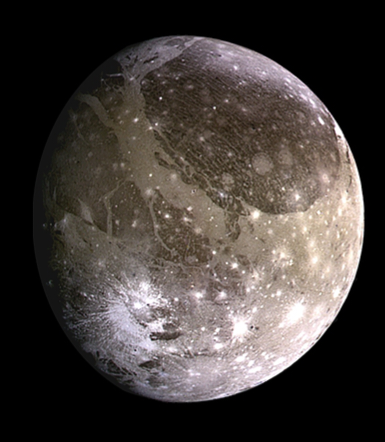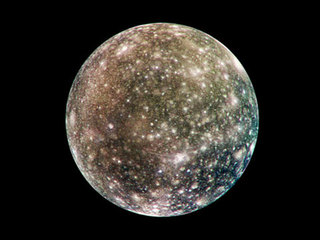*This post may contain affiliate links. This means we may make a commission if you purchase an item using one of our links*
The main differences between Ganymede and Callisto is that Ganymede is the largest moon in our solar system with a diameter of 5,268km whilst Callisto is the 3rd largest with a diameter of 4,820.6km, Ganymede has a magnetosphere whilst Callisto does not and Ganymede is located 1.07 million km from Jupiter whilst Callisto is further away at a distance of 1.88 million km.
For a more detailed look at each of these natural satellites, continue reading as the other differences and similarities will be broken down in more detail below.
What Is The Moon Ganymede?
Table of Contents

Ganymede is the largest of the Galilean moons – and the largest moon in our entire solar system – first discovered on 7th January 1610. The surface of this icy world is frozen and covered by two main types of landscape: young, light regions and old, crater-filled terrain. And these darker areas seem to contain a number of organic materials.
Using the Hubble Space Telescope, astronomers have found evidence of an oxygen-based atmosphere. Still, it is far too thin to support any living organisms that we know of. Based on this, it’s unlikely that Ganymede hosts life as we know it.
Estimates place Ganymede at around 4.5 billion years old (the same age as its planet, Jupiter), and its average distance from the Sun is approximately 778 million km.
Its diameter is 5,268km, making it larger than the planet Mercury. Despite this, Ganymede only possesses half the mass of Mercury at 1.48 × 10^23kg, so it is still classified as a low-density object.
Ganymede takes seven days to orbit its planet at an average distance of 665,00km, and the temperature varies from minus 112 to minus 193 degrees Celsius. In regards to the moon’s core temperature, that would be around 1,226 – 1,446 degrees Celsius.
Among the fascinating features of this ice moon is its magnetosphere. While many planets possess a magnetosphere, no other moon in our solar system shares this trait.
Measuring the changes in the magnetic fields of Ganymede and Jupiter allowed scientists to predict that salt water lies beneath the surface of this freezing world.
However, this is insufficient to support life when you factor in the other elements of this giant moon. In contrast to Europa, the rocky layer of Ganymede is not directly below the ocean, so life would have a difficult time forming both above and below the ice.
In addition, the thick layer of ice on the moon’s surface would make internal, water-based life challenging for scientists to detect.
What Is The Moon Callisto?

Callisto is one of the large moons orbiting Jupiter, the outermost of the Galilean moons, first discovered on 7th January 1610. The surface of this icy world is frozen, but scientists believe an underground ocean could reside beneath the ice.
Even if there’s water on Callisto, it won’t necessarily hold life because the surface is so old. Scientists will need to conduct more research into the moon before determining whether this is a likely possibility.
The ESA’s JUICE (Jupiter Icy Moon Explorer) mission is focused on the three ice moons of Jupiter. It is expected to arrive in 2030 and will focus on learning more about the environment of each, as well as their potential for hosting life.
Scientists estimate that Callisto is around 4.5 billion years old (the same age as Jupiter), and its average distance from the Sun is approximately 778 million km. It has a diameter of 4820.6km, which makes it similar in size to the planet Mercury, and the average temperature is a frigid minus 139.2 degrees Celsius.
Callisto takes seven days to orbit its planet at an average distance of 1,880,000km, and it is tidally locked, meaning the same side of it always faces Jupiter. But this moon experiences less tidal influence than the other Galilean moons because it lies in the orbit of Jupiter’s primary radiation belt.
The name of this moon is derived from the stories of Greek myth. Callisto was the nymph who had an affair with Zeus, the King of the Gods. Upon hearing this news, Zeus’ wife Hera turned Callisto into a star and placed her in the Ursa Major constellation. Interestingly, every moon of Jupiter is named after a Greek figure who Zeus seduced.
Callisto may be the third biggest moon and similar in size to the planet Mercury, but it only has a mass of 107,593,737,963.819 billion kg. That may sound like a lot, but it’s only ⅓ the mass of the similarly sized Mercury.
You may wonder why scientists classify Callisto as a “moon” rather than a planet if it’s almost the same size as Mercury. The reason is simple; planets must orbit the sun, but Callisto orbits one of the planets.
The composition of this frigid world is around 60% rock and iron and 40% ice. The moon has roughly equal amounts of rock and ice, plus the potential for water below the surface. There are also traces of carbon dioxide, organic compounds, and silicates.
This moon is one of the oldest landscapes in the Milky way and the most heavily cratered body in our system. However, scientists believe this could now be a “dead” moon as there are no longer any signs of volcanism or plate tectonics on its surface.
Similarities Between Ganymede And Callisto
As both are natural satellites, Callisto and Ganymede do share a few similarities, which includes the following:
- Both have a hotter central core.
- Both have a rocky, terrestrial surface.
- Both are spherical in shape.
- Neither have rings surrounding them.
- Both are tidally locked to Jupiter.
- Both orbit Jupiter in an elliptical pattern.
- Neither have tectonic plates.
Differences Between Ganymede And Callisto
- Ganymede has a magnetosphere whilst Callisto does not.
- Callisto is smaller with a diameter of 4,820.6km making it the 3rd biggest moon whilst Ganymede’s diameter is 5,268km making it the largest moon in our solar system.
- A day on Callisto is 17 days whilst Ganymede’s day is 7 days and 3 hours.
- Ganymede’s axial tilt is 0 – 0.33 degrees whilst Callisto’s is 0 degrees.
- Callisto has a temperature of -138 degrees on average whilst Ganymede’s temperature is around -112 to -193 degrees Celsius.
- Callisto is less dense with a density of 1.83 g/cm³ whilst Ganymede has a density of 1.94 g/cm³.
- Callisto’s gravitational strength is 1.236 m/s² whilst Ganymede’s gravitational strength is 1.428 m/s²
- In regards to mass, Ganymede’s is 1.48 × 10^23kg whilst Callisto has a mass of 1.07×10^23 kg.
- In regards to their distance from Jupiter, Callisto’s is 1.88 million km whilst Ganymede’s is 1.07 million km.
- Callisto is amongst the most cratered moon in the solar system whilst Ganymede is less so.
Summary
As Ganymede and Callisto are both one of Jupiter’s Galilean moons and are also amongst the largest natural satellites in our solar system, they in turn naturally have their fair share of similar features such as their very thin atmospheres, their terrestrial composition, being tidally locked to Jupiter and beyond.
However, they differ in a variety of ways too. Whether it be in regards to mass, size, the length of their days. magnetosphere activity and more, so even if these two do share a lot of common features they are still very much distinct entities in the end of the day.

